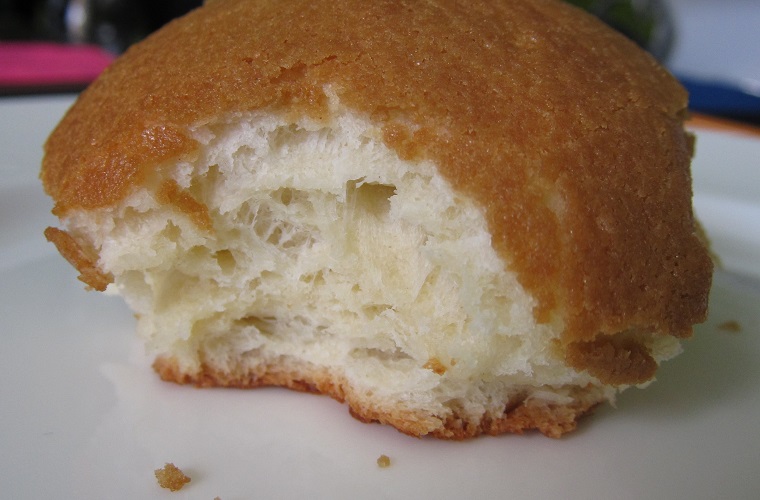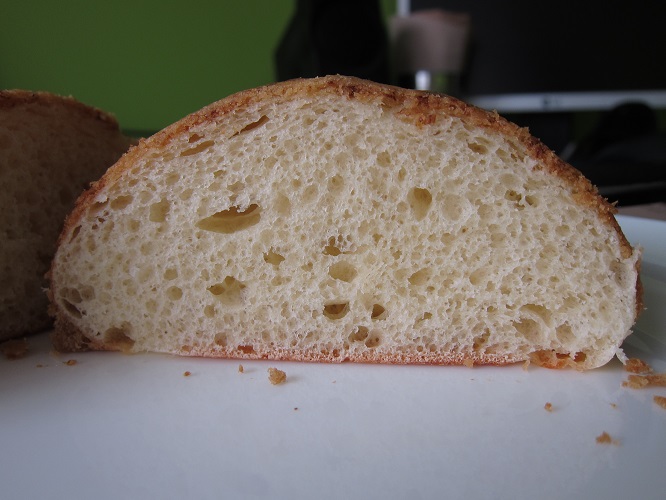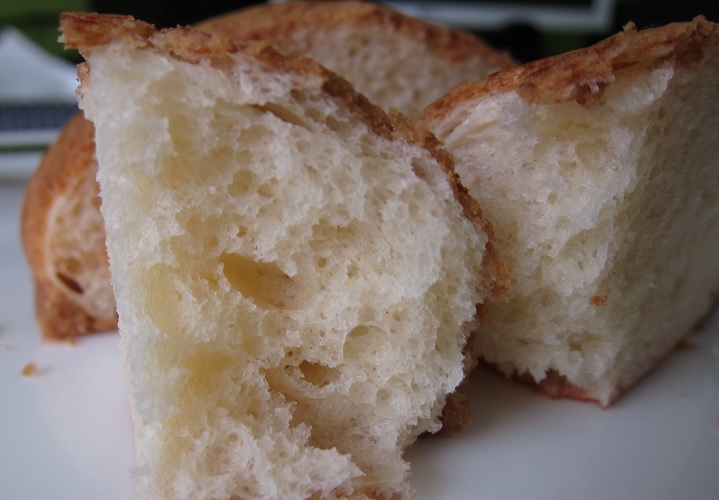Hi Everyone,
Today I made some chinese bakery buns that came out with a "cakey" crumb. These buns are supposed to have a airy, chewy and stringy crumb that you can kind of peel apart into strands. I've been successful at achieving this before, but today I used the same recipe with a new bag of flour and ended up with buns that were soft and airy, but not really chewy or stringy like before. See the old vs. new photos below.
I'm not really sure what went wrong. The flour I used was "hard unbleached flour", which I assumed was equivalent to bread flour. Did I assume correctly? Also, is it possible that I just need to handle the flour differently? More kneading time? Less water (the dough seemed a little slack)?
Thanks for any advice!
Photos:
The original bun. Not a great photo, but you can kind of tell that the crumb is chewy and sort of stringy. If I pulled it apart, I would get "whisps" of bread.

Today's bun. I don't get "whisps" of bread when I pull it apart. It kind of just tears like a cake.


I have encountered this before,also, and this is one of the reasons why I think recipes can be considered "guidelines". Whenever I change brands of flour, I have discovered the first few bakes are like making a new recipe. The flour may behave differently than the other brand and you have to figure out how to get the best out of it for your baking.
The crumb definitely looks like you either need to knead more when you use that particular flour to develop the gluten or you need a higher gluten flour.
It may take a few times before you get where you want with this flour but you can get there.
Have delicious fun!
I think I will try kneading it longer then. I got my flour from a wholesaler and there wasn't any indication of protein content on the packaging. However, the recipe I use includes a 1% addition of vital wheat gluten, so I feel lke there should be a decent amount of gluten. Fingers cross for the next batch! Thanks Clazar.
Photos don't always really communicate what you want them to. The second photo looks like a nice bread. I have no idea how the crumb feels, and I can accept that it isn't what you were looking for.
Typically cakey crumbs, and we may not mean the same thing with those words, are caused by too dry a dough. I'd add more liquid to the dough. Also, as you rise, punch down, re-rise, punch down, loaf and rise a bread... the crumb becomes finer and more consistent with each cycle. I think you might want to move to a cycle where you knead the dough, let it rest, loaf it, let it rise and then bake it.
Did the dough rise quicker than normal and become progressively wetter? I had something similar recently and the interior reminded me of squishy cakey wonderbread, and I did not add any fat. It puffed up massively quick and then it let me down just as fast.
The dough actually rose slower than I had expected. It was also felt a bit softer and spread more than usual. Does that say anything?
Sorry for resurrecting this post, but I think I've figured out what went wrong with the bread in the original post. I just wanted to wrap up this thread so it is hopefully useful to someone else in the future.
Today, I tried making some similar buns. I am almost certain that gluten development was sufficient as I obtained a very thin windowpane that was resistant to tearing. I was really hopeful this time, but the resultnig bread had an almost quickbread-like crumb. Proofing took a very long time even at warm temperatures, the dough spread a lot during proofing, and oven spring was minimal.
I ruled out poor quality flour as I had a successful windowpane test and as I previously made a no-knead loaf with very good results using the same flour. After reading tons of posts, I began suspecting my yeast and lo and behold, a quick test of my yeast showed that it is definitely not as lively as expected.
After reading many posts, I think that 1) the dead yeast was resulting in poor rises and 2) the dead yeast products (e.g. glutathione) were breaking down the glutent contributing to slack during proofing and resulting cakey texture. In my no-knead loaf, I started with very little yeast so there were fewer dead yeast products, and the proofing time was very long so the yeast had time to multiply and do their work. I assume that this is why the no-knead loaf was successful even though I used the same flour and same yeast.
I'll need to confirm all of this with some new active yeast once this current bake has all been consumed. Hope this was informtive :)